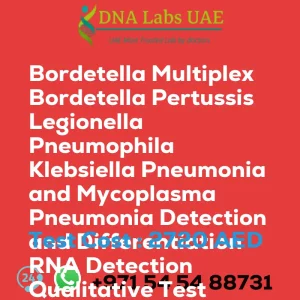Dengue Virus and Chikungunya Virus Viral Load Quantitative Test
Test Name: Dengue Virus and Chikungunya Virus Viral Load Quantitative Test
Components: Whole Blood, Serum, Plasma, C.S.F
Price: 1000.0 AED
Report Delivery: 3rd Working Day
Email: 36 hours
On phone: 24 hours
Method: Real Time PCR
Test type: Viral
Doctor: Physician
Test Department: Genetics
Pre Test Information: Need to sign Consent document and bring any clinical history of patient for Dengue Virus and Chikungunya Virus Viral Load Quantitative Test
Test Details:
A Dengue Virus and Chikungunya Virus Viral Load Quantitative Test is a laboratory test that measures the amount of Dengue virus or Chikungunya virus in a person’s blood. These tests are used to diagnose and monitor the progression of these viral infections. The test is typically performed using a technique called polymerase chain reaction (PCR), which amplifies the genetic material of the virus present in the blood sample. The amplified genetic material is then quantified to determine the viral load, or the number of viral particles present in the blood.
The viral load quantification can provide valuable information about the severity of the infection and help guide treatment decisions. It can also be used to monitor the effectiveness of antiviral treatments or the progression of the infection over time. In general, a higher viral load indicates a more severe infection and may be associated with more severe symptoms and complications. Monitoring the viral load can help healthcare providers assess the effectiveness of treatment and adjust the management plan accordingly.
It’s important to note that the viral load test is not typically used as a standalone diagnostic tool. Other tests, such as serological tests that detect antibodies against the virus, are often performed in conjunction with the viral load test to confirm the diagnosis of Dengue or Chikungunya virus infection.
Overall, the Dengue Virus and Chikungunya Virus Viral Load Quantitative Test plays a crucial role in the diagnosis, management, and monitoring of these viral infections.
| Test Name | Dengue Virus and Chikungunya Virus Viral Load Quantitative Test |
|---|---|
| Components | |
| Price | 1000.0 AED |
| Sample Condition | Whole Blood, Serum, Plasma, C.S.F |
| Report Delivery | 3rd Working Day Email:-36 hours. On phone: 24 hours |
| Method | Real Time PCR |
| Test type | Viral |
| Doctor | Physician |
| Test Department: | Genetics |
| Pre Test Information | Need to sign Consent document and bring any clinical history of patient forDengue Virus and Chikungunya Virus Viral Load QuantitativeTest |
| Test Details |
A Dengue Virus and Chikungunya Virus Viral Load Quantitative Test is a laboratory test that measures the amount of Dengue virus or Chikungunya virus in a person’s blood. These tests are used to diagnose and monitor the progression of these viral infections. The test is typically performed using a technique called polymerase chain reaction (PCR), which amplifies the genetic material of the virus present in the blood sample. The amplified genetic material is then quantified to determine the viral load, or the number of viral particles present in the blood. The viral load quantification can provide valuable information about the severity of the infection and help guide treatment decisions. It can also be used to monitor the effectiveness of antiviral treatments or the progression of the infection over time. In general, a higher viral load indicates a more severe infection and may be associated with more severe symptoms and complications. Monitoring the viral load can help healthcare providers assess the effectiveness of treatment and adjust the management plan accordingly. It’s important to note that the viral load test is not typically used as a standalone diagnostic tool. Other tests, such as serological tests that detect antibodies against the virus, are often performed in conjunction with the viral load test to confirm the diagnosis of Dengue or Chikungunya virus infection. Overall, the Dengue Virus and Chikungunya Virus Viral Load Quantitative Test plays a crucial role in the diagnosis, management, and monitoring of these viral infections. |








